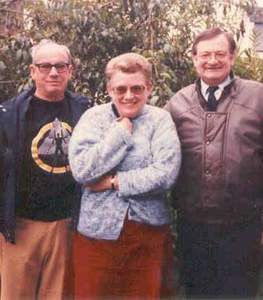Monique was a wounded baby in a crib and I met Paul outside his home where his Mother, sister, and grandfather were murdered by German SS Troops.

Charles Corbin Monique Thonon Paul Kline
The reason I returned to Parfondruy
was because of these two people.
Monique was a wounded baby in a
crib and I met Paul outside his home
where his Mother, sister, and grandfather
were murdered by German SS Troops.

Charles Corbin Monique Thonon Paul Kline
On Dec.20, 1944 our R.O. (Reconnaissance Office) half-track, of which I was chief of section from A Battery, 391st. Armored Artillery 3rd. Armored Division. passed through Spa, Belgium, and then through a large gasoline storage area in a wooded area. We sat up a communication relay station because of radio reception and visibility was very poor.
On the 21st. we got orders to report to a task force in Stoumont, but could not get by a column of tanks, and got stuck in a stream when we tried to bypass them on a trail. We then got a call to report to Col. Lovelady' s Headquarters, as Stoumont was not in our hands. A Captain Peters toll us to report to Lt. Edmark of D/33, a small task force of Col. Lovelady's in the village of Parfondruy, to give artillery support. We were escorted part way and were told to move fast as the Germans had observation on the road. We did move fast and when we rounded a corner and stopped beside the first house on our right, The Villa Epilogue as there was a building on fire lighting up the sky as it became dark. Lt. Plummer our new F.O. said he would go ahead on foot and make contact with D Co. and make sure it was in our hands and all of us wouldn't get captured.
Meanwhile some of the people came out of the Villa and asked for help, as there were several wounded inside. William Whitten, Roland Mniece, Howard Jenkins and communication Sgt. Taggart went in and begin to administer first aid, while the rest of our section stayed on the guns. We had 3-30-cal. and one 50 -cal. machine guns. We soon got a signal from Plummer to come on in as he was about a mile away. The guys were reluctant to leave when I came in to get them loaded up. They were bandaging a woman's left arm which had a bullet wound. They left most of our first aid supplies and climbed over the side of the half-track, as we were only about 15 ft. from the door to the side of the road.
We passed the burning building on our right and met Plumber at the first corner intersection and then to Lt. Edmark's C.P. who had made room for us in a room there. There was about six inches of snow and it was very cold. We covered the windows and built a fire. I got out my favorite stove, a non issue blowtorch, and heated up some 10 in 1 rations. Lt. Edmark came in while we were were eating and gave us the lowdown or the big picture as they use to say. We had nine tanks, a platoon of infantry, and mortars, a few engineers and medics, and we had to hold our position. Lt. Edmark had led D. Co. from Peti Coo to take possession of Stavelot, but was stopped at the edge of Parfondruy on the Coo road by large number of infantry and tanks, in the afternoon. They had killed lots of Germans and knocked out several tanks and had a few prisoners. The fighting was ending as we arrived.
In the night, instead of sending Bed Check Charlie, the Germans sent a couple of buzz bombs that shook us. The next morning while scouting our position I enter a house and saw a dead elderly couple, bullet holes in their head, their throats cut, lying in their blood. Another house had two men and a baby dead in a crib, one of the women was nude with a bullet hole in her head and part of her left arm hacked off. Another house in a large closet was about six children shot, some with heads smashed. I was at a corner standing in a yard when two children appeared like out of the fog, and said "Vive La Americk". One of our soldiers stopped them and told them not to enter the house, as the people were dead. They said they were looking for their parents and relatives and went in. I went back to our C.P. in a daze.
William Whitten and I had just turned the 20-year mark less than two weeks ago. It was hard to get our minds back on the war. All afternoon we could see the German troops across the railroad marching on the Stavelot road toward Trois Ponts but could not see our artillery shells because of haze and fog. and slow communications. I went upstairs in a house on a hill behind us to observe better. There under our nose was a large German tank in some trees. After telling Plummer and Edmark we got artillery on it and flushed it out where one of D's Co. tanks had a clear shot at it. and shoot it he did but three balls of fire bounced off of it and it backed away never moving its turret.
Page 2